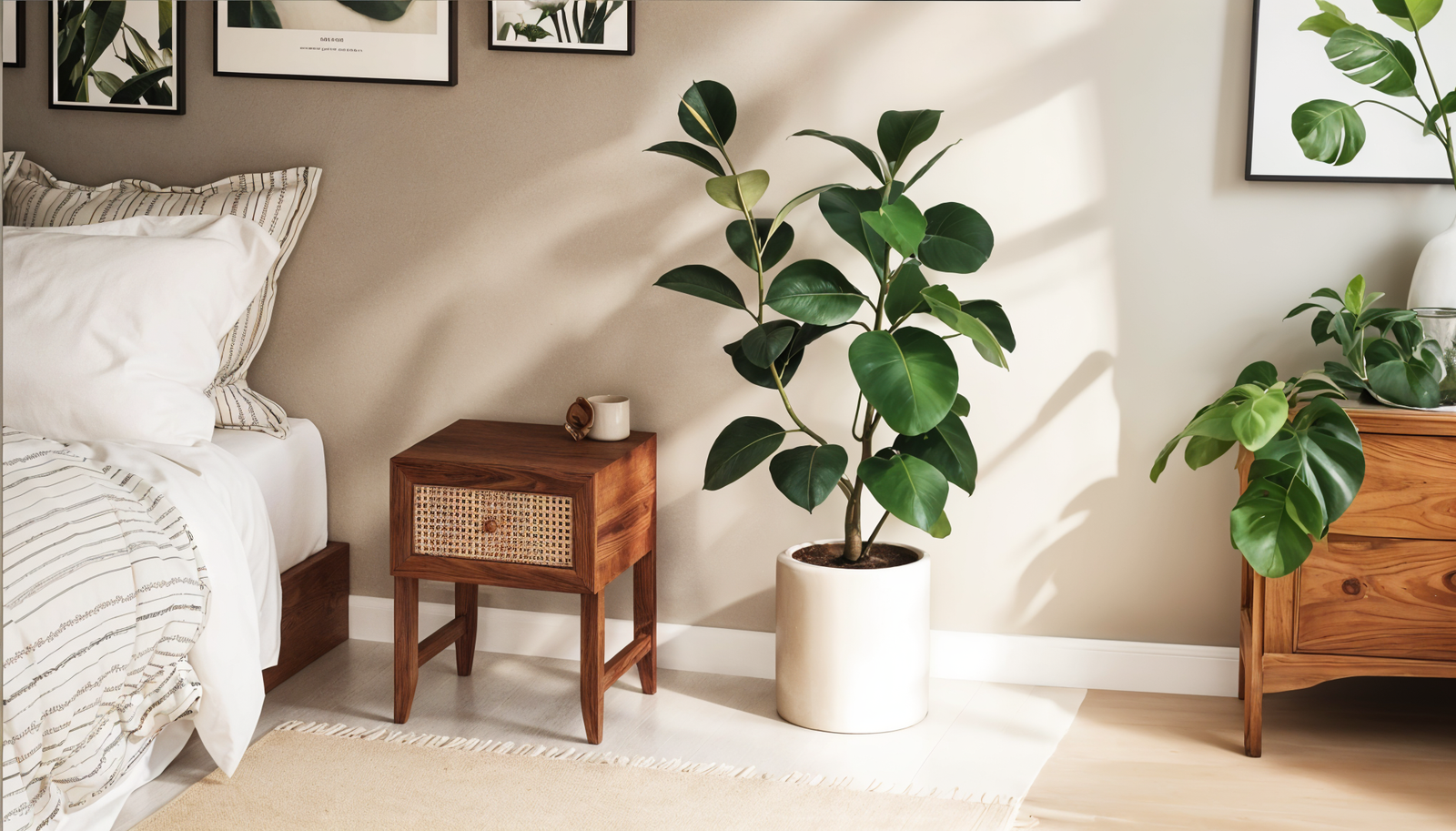🤍 Unmatched Quality, Authentic Craftsmanship
🤍 Unmatched Quality, Authentic Craftsmanship
🤍 Unmatched Quality, Authentic Craftsmanship
In today's world, more and more people are becoming conscious of the impact their choices have on the environment. This includes the furniture we choose to bring into our homes.
Sustainable furniture is a growing trend that focuses on using eco-friendly materials and manufacturing processes to reduce harm to the planet.

But what exactly is sustainable furniture made of? And how can you be sure that the furniture you're purchasing is truly sustainable?
This guide will provide you with all the information you need to make informed choices when it comes to sustainable furniture.
From exploring different materials and their environmental impact to understanding the certifications and labels to look out for, this article will help you navigate the world of sustainable furniture and make choices that align with your values.
So, if you're interested in creating an eco-friendly home, keep reading to learn more about sustainable furniture and how you can incorporate it into your living space.
When it comes to sustainable furniture, there is a lot to consider. From the materials used to the way in which it’s manufactured, sustainability extends far beyond just environmental impact.
To truly understand what makes furniture sustainable, let us understand what sustainable furniture is and some of its benefits.
Sustainable furniture is an environmentally friendly choice that supports the health of our planet. It refers to furniture pieces that are made from materials and processes that are designed to reduce environmental impact.
Sustainable furniture is generally made with natural, renewable, or recycled materials, such as wood, bamboo, cork, organic cotton, hemp, and wool. These materials are often sustainably sourced and ethically produced to help reduce the negative impacts of production, such as air and water pollution.
In addition, sustainable furniture is often designed with longevity in mind, meaning it’s built to last and can be repurposed or recycled at the end of its lifespan. This helps to reduce waste and lessen the demand for new resources.

When looking for furniture, it’s important to consider the benefits of choosing sustainable furniture. Sustainable furniture offers numerous advantages that make it an attractive option for eco-conscious homeowners.
Sustainability
One of the primary benefits of sustainable furniture is its sustainability. By choosing furniture made from natural, renewable, and recycled materials, you can help reduce your environmental impact and lessen the demand for new resources.
Durability
Sustainable furniture is often designed with longevity in mind and made with high-quality materials that are built to last. Because of its superior quality, it can often be used for years to come.
Long-lasting
Sustainable furniture is designed to last longer than traditional pieces, reducing the need for frequent replacements.
Health benefits
Sustainable furniture is good for your health. It is made from eco-friendly materials that are non-toxic and free from toxic chemicals, harmful gases, and dyes. It is also designed for comfort and can help reduce fatigue and improve posture.
Low carbon footprint
Sustainable furniture is made with materials sourced from sustainable sources, such as plantations or recycled materials. This helps reduce the amount of CO2 released into the atmosphere during production.
Ethical production
Sustainable furniture item is often produced in an ethical manner, helping to support local communities and reduce the exploitation of workers and resources.
In short, sustainable furniture is an excellent choice for those looking to create an eco-friendly home.
When it comes to buying sustainable furniture, there are a few important considerations to keep in mind. Here are some tips for choosing the best sustainable furniture for your home:
Materials Used
One of the most important things to look at when purchasing sustainable furniture is the materials used. Try to choose pieces made from natural, renewable, or recycled materials, such as wood, bamboo, organic cotton, hemp, and wool.
Production Standards
Look for furniture that is produced in an ethical manner with strict standards of production. This helps to ensure that the manufacturing process is not contributing to any environmental degradation or exploitation of workers or resources.
Manufacturer Reputation
Try to choose furniture from a manufacturer whose reputation for sustainability and ethical practices is solid. A good way to do this is to look for certifications from organizations like the Forest Stewardship Council (FSC) or Greenguard that guarantee that furniture has been produced in a responsible manner.
Longevity and Durability
Choose furniture that is built to last with high-quality materials and construction. This will help reduce the need for frequent replacements, saving money in the long run.
Price
Sustainable furniture can be more expensive than traditional pieces. Try to find pieces that are within your budget while still ensuring that production is ethical and sustainable.
Maintenance
Sustainable furniture is designed with longevity in mind, but it still needs regular maintenance to look its best. Make sure to follow the manufacturer’s instructions for care and cleaning, as this will help keep your furniture looking great for years to come.
Now that you have a basic understanding of sustainable furniture, its benefits, and factors to consider when making a purchase, let's discuss in detail the materials used to make sustainable and eco-friendly furniture.

Sustainable furniture is made from eco-friendly materials that are non-toxic and free from harmful chemicals and dyes.
Common materials used to make sustainable furniture include wood, bamboo, organic cotton, hemp, wool, jute, seagrass, cork, recycled plastic, and natural latex.
These sustainable materials are sourced from renewable sources and can be recycled or composted after use.
FSC-certified wood and bamboo are two of the most popular materials used to make sustainable furniture.
FSC-certified wood is harvested from forests that are well-managed and comply with strict environmental and social standards.
Bamboo is a rapidly renewable material that is sustainably harvested and requires minimal energy for processing.
Both materials are durable and beautiful and can help reduce your carbon footprint.
Organic cotton and hemp are two of the most sustainable fibers for furniture production.
They're grown without the use of pesticides or synthetic fertilizers, making them healthier for both the environment and consumers.
They're also incredibly durable and soft, making them ideal materials for furniture upholstery.
Sustainable furniture often uses recycled and reclaimed materials.
These materials come from post-consumer or post-industrial products.
They are repurposed to make furniture with less environmental impact.
Examples include plastic bottles, newspaper, cardboard, and metal cans.
These materials are eco-friendly alternatives to traditional furniture.
Natural fibers and textiles are popular for sustainable furniture.
They include organic cotton, hemp, wool, jute, and seagrass.
These materials are grown without synthetic fertilizers or pesticides.
As a result, they are more eco-friendly than traditional fabrics and require fewer resources to produce.
They are also durable and often biodegradable, making them a great sustainable choice for furniture industry.
Non-toxic and low-VOC finishes are crucial for sustainable furniture construction.
These finishes are free from harmful toxins, chemicals, and VOCs that can harm the air or be absorbed through the skin.
Low-VOC finishes use water-based products that emit fewer VOCs than solvent-based ones.
They also help reduce the environmental impact of furniture production.
Now that you know the sustainable materials used in sustainable furniture, it's time to learn about some of the production processes and practices regarding sustainable furniture making.

When it comes to sustainable furniture production, manufacturers must consider the energy used in the process as well as the materials used.
Sustainable furniture is created using practices that are designed to reduce environmental impact.
These practices include:
Responsible sourcing and production methods are key when it comes to sustainable furniture production.
Manufacturers should source materials from renewable sources, such as FSC-certified woods, organic cotton, and hemp.
They should also strive to reduce energy consumption during the manufacturing process by using efficient technologies.
Additionally, manufacturers should use non-toxic finishes and low-VOC paints to reduce air pollution.
Energy-efficient manufacturing processes are essential for sustainable furniture production.
Manufacturers should use energy-efficient methods such as minimizing waste, using renewable energy sources, and investing in energy-efficient technologies.
This process helps reduce the environmental impact of production and helps create a more sustainable product.
Additionally, manufacturers should strive to recycle materials whenever possible, which can also help save resources and reduce emissions.
Waste reduction and recycling initiatives are important for sustainable furniture production.
Manufacturers should strive to minimize waste from the production process and ensure that any materials that are not used during production are recycled whenever possible.
Additionally, manufacturers should look into programs such as upcycling, where items that are no longer needed can be repurposed into new products.
By implementing these initiatives, manufacturers can reduce their environmental impact and help create a more sustainable product.
Fair labor practices and ethical production are essential for sustainable furniture production.
Manufacturers should ensure that all workers involved in the production process are treated fairly, with respect for their rights and safety.
They should also provide fair wages, as well as provide safe working conditions and ensure labor standards such as no child labor or forced labor.
Additionally, manufacturers should strive to reduce gender inequality in their workforce and promote diversity in their manufacturing processes.
By following these practices, manufacturers can ensure that their furniture is created sustainably and ethically.
By investing in sustainable materials, energy-efficient production processes, waste reduction and recycling efforts, and fair labor practices, manufacturers can help create a more sustainable product that reduces environmental impact.
In the next section, we will discuss some of the more important factors to consider when looking for a sustainable option for your next furniture purchase.
When it comes to sustainable furniture, there are several other factors that should be taken into consideration when making a purchase.
Sustainable furniture is designed to last much longer than conventional furniture, which means that investing in a sustainable option will save money in the long run.
Sustainably sourced materials such as FSC-certified woods are extremely strong and durable, while organic cotton and hemp fabrics can withstand wear and tear.
End-of-life considerations and recyclability are important factors to consider when looking for sustainable furniture. Manufacturers should strive to ensure that their products are designed with the end of life in mind, meaning that they can easily be disassembled or recycled after use.
Additionally, manufacturers should look into using recycled materials in production, as this helps to reduce emissions associated with creating new materials. Recycled materials can also be used to create furniture with unique and interesting designs.
When it comes to finding sustainable furniture, certifications and labels are important factors to consider. These labels act as quality assurance that the product has been created with sustainability in mind.
The Forest Stewardship Council (FSC) certification is a popular label to look for when it comes to sustainable furniture. This certification ensures that the materials used to create the furniture have been sustainably sourced.
The Global Organic Textile Standard (GOTS) is another certification to look for when it comes to sustainable fabrics. This label ensures that any organic cotton or hemp used in the production of furniture has been grown and processed with safety and sustainability in mind.
Additionally, manufacturers should strive to obtain LEED certification, which stands for Leadership in Energy and Environmental Design. This certification ensures that the furniture has been created using environmentally friendly practices such as energy-efficient production methods, reducing waste and water use, and utilizing renewable energy sources.

Supporting local and small-scale artisans is an important factor to consider when looking for sustainable furniture. Buying locally-made furniture ensures that materials are sourced from the local area, reducing the environmental impacts associated with long-distance transport.
Additionally, it supports local businesses and helps to create jobs in the community. Small-scale artisans often use traditional methods of craftsmanship when creating furniture, meaning that the pieces are often of high quality and unique.
When looking for sustainable furniture, it’s important to consider both style and sustainability. It’s possible to find furniture that is both stylish and sustainable, but there are some considerations that need to be taken into account when making the decision.
Consider the aesthetic you want. Sustainable furniture uses natural materials like wood, bamboo, and hemp. Make sure it matches your existing décor. Also, think about how you'll use the furniture. Different materials are better for different purposes, so think about that before buying.
Also, consider the durability of the item and how long you plan to keep it before buying sustainable furniture.
Finally, consider sustainable furniture for your home or office. Look for certifications, support local artisans, and balance style and sustainability.
Now that you know what to look for, you can make an informed decision when it comes to finding sustainable furniture.
After going through all the information provided above, you might still have some questions lingering in your mind.
In this section, we have attempted to address many of these questions, ranging from the basic to the more complex.
So, let's take a look at some of the frequently asked questions about sustainable furniture.
When shopping for sustainable furniture, it is important to make sure that the brand you are considering is truly sustainable.
This can be done by looking for certifications like FSC and GOTS or by researching the company’s environmental policies and practices.
It is also important to check for reviews from other customers to get an understanding of how the brand performs in regard to sustainability.
Additionally, look for locally made furniture, as this supports local businesses and reduces the environmental impacts associated with long-distance transport.
Incorporating sustainable furniture into home decor can be a great way to make your home look stylish while also reducing your environmental impact.
The key is to choose pieces that are both aesthetically pleasing and sustainable.
To start, look for locally made furniture that uses renewable materials like wood, bamboo, or hemp.
Additionally, consider investing in vintage, second-hand furniture, as this is often more affordable and just as stylish.
Finally, make sure to research the item thoroughly to ensure that it is made in a sustainable manner.
In conclusion, sustainable furniture is not only environmentally friendly but also beneficial for your health and well-being.
It is made from a variety of materials, such as reclaimed wood, bamboo, recycled plastic, and organic textiles.
When shopping for sustainable furniture, look for certifications like FSC and Greenguard to ensure its authenticity.
By choosing sustainable furniture, you can reduce your carbon footprint, support ethical sustainable practices, and create a healthier living environment.
Additionally, incorporating sustainable furniture into your home decor can add a unique and stylish touch to your space.
So, make a conscious choice and opt for sustainable furniture to make a positive impact on both the planet and your home.


